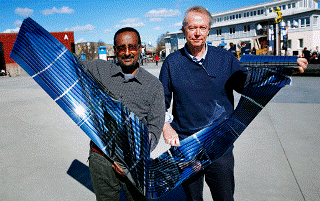Apr 20 2016
Researchers from the Chinese Academy of Sciences (CAS) and at Linköping University have demonstrated the possibility of developing highly efficient and more reliable polymer solar cells at a lower cost. The breakthrough research is focusing on the development of polymer solar cells without using unstable and expensive fullerenes.
 Researchers Olle Inganäs and Shimelis Admassie demonstrate solar cells on a roll. Photo: Stefan Jerrevång
Researchers Olle Inganäs and Shimelis Admassie demonstrate solar cells on a roll. Photo: Stefan Jerrevång
Recently, polymer solar cells have surfaced as an inexpensive alternative to silicon solar cells. High efficiency is obtained when fullerenes are used in polymer solar cells to split the charge carriers. However, under illumination fullerenes are found to be unstable, forming big crystals at high temperatures.
At present, a team of chemists headed by Professor Jianhui Hou at the CAS has achieved a new world record polymer solar cell that does not have fullerenes. This record was obtained by creating a novel combination of a small molecule called ITIC and a polymer called PBDB-T. This combination helps to convert the energy from the sun with an efficiency of 11%, which is a value that strikes most of the solar cells containing fullerenes, and all without fullerenes.
Feng Gao along with his collaborators Olle Inganäs and Deping Qian at Linköping University have analyzed the loss spectroscopy of photovoltage (Voc), a critical value for solar cells. They also suggested approaches that will help to enhance the performance of the device even further.
Both the research groups are currently presenting their findings in Advanced Materials.
We have demonstrated that it is possible to achieve high efficiency without using fullerene, and that such solar cells are also highly stable to heat. Because solar cells are working under constant solar radiation, good thermal stability is very important. The combination of high efficiency and good thermal stability suggests that polymer solar cells, which can be easily manufactured using low-cost roll-to-roll printing technology, now come a step closer to commercialization.
Feng Gao, Physicist, Department of Physics, Chemistry and Biology, Linköping University.